| |
Lab Activity 9.3
Tidepool Microhabitats
|
|
|
|
Directions
|
|

|
Study
the instructional material below. Be sure to click on each of the photographs
for an enlarged view in a separate window. The
larger version is necessary to complete the assignment.
It opens in a separate window which can be resized by grabbing the bottom
right corner and dragging it. It
can also be moved by
grabbing the top heading bar and dragging it.
Be sure to close the extra window by using the X in IBM, or the close box
in MAC when you are finished using them. |
|
|
Introduction
|
|

|
Marine
biologists have found rocky shores convenient sites to study the interactions
between organisms and their environment. Rocky intertidal organisms line
in an environment that has both terrestrial and marine aspects. They have
unique adaptations that allow them to survive in this in between world.
Each species lives within a specific range of microhabitats that provide
for its needs. In this lab you will study a subtropical, rocky, intertidal
reef located in the Northern Gulf of california. Your studies will include
an examination of the basic biotic and abiotic characteristics of this environment.
You will consider the effects of habitat heterogeneity on the distribution
of the benthic flora and fauna. In this particular lab activity you will
study the biota associated with tidepool microhabitats. |
|
 Instruction
Instruction
|
|

|
Study
the information and photographs in the exercises that follow. Click the
link and use the Checklist of
the Biota of Tidepool Microhabitats to record and keep track of the
species you find in tidepool microhabitats described below. Copy the checklist
into your notebook or print the checklist and add it to your notebook. Check
off the species you find in each microhabitat as you study the biota. Use
the completed checklist to answer the study questions. Be sure to write
the answers to the study questions in your notebook.
Be sure
to write about what you are learning in the lab section of your notebook.
You will be expected to answer questions about the lab activity during
the lab self test and lab quiz. It helps to have your text and coloring
books open beside you for support.
|
| |
| Supporting
Information |
| Refer
to the Assigned Readings Below: |
| Marine
Biology Textbook |
Chapter
11, pages 236 to 244 |
| Marine
Biology Coloring Book |
Plates
3 to 6 |
|
| |
|
Upper
Tidepools
|
|
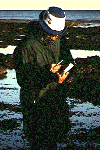 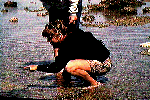 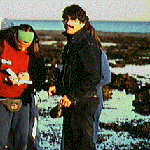
|
|
Observations:
The tidepools lying
close to the sandy beach are located at tidal heights between +1
and +2 feet. These tidepools are inhabited by a different association
of organisms from those located lower in the intertidal. The upper
pools are at greater risk of draining completely during spring tides
and experience greater temperature changes than the lower pools.
|
|
Lower
Tidepools
|
|
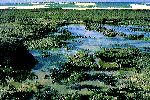 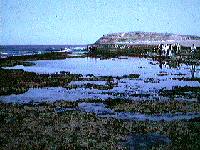 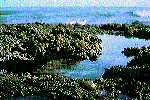
|
|
Observations:
The tidepools lying
close to the low tide line are located at tidal heights between
-1 and +1 feet. These pools are inhabited by a different association
of organisms from those located higher in the intertidal. The lower
intertidal tidepools are cut off from the sea for short periods
of time during spring tides only.
|
|
Study Questions:
- Develop a species
list of seaweeds found in tidepools.
- What generalizations
can you make about the types of seaweeds found in tidepools?
- How many species
are there?
- Does one general
type predominate?
- Are any of the
species found in beachrock microhabitats as well?

Click
to observe seaweeds
|
|
Study Questions:
- Develop a species
list of invertebrates found in tidepools.
- What generalizations
can you make about the types of invertebrates found in tidepools?
- How many species
are there?
- Does one general
type predominate?
- Are any of the
species found in beachrock microhabitats as well?

Click
to observe invertebrates
|
|
Study Questions:
- Develop a species
list of molluscs found in tidepools.
- What generalizations
can you make about the types of molluscs found in tidepools?
- How many species
are there?
- Does one general
type predominate?
- Are any of the
species found in beachrock microhabitats as well?

Click
to observe molluscs
|
|
|
|
|
|
|
|
|
|






